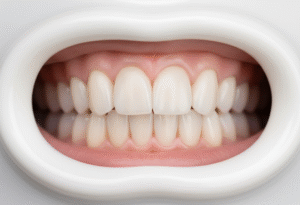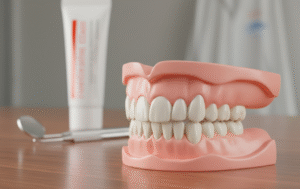A bright, white smile can boost your confidence and make a lasting first impression. While there are various teeth whitening methods available, whitening strips have become a popular and effective at-home option. This guide will provide a comprehensive overview of teeth whitening strips, their benefits, how they work, potential side effects, and tips for best results.
What Are Teeth Whitening Strips?
Teeth whitening strips are thin, flexible pieces of plastic coated with a gel that contains a peroxide-based whitening agent. This agent penetrates the enamel to remove surface stains and lighten the color of your teeth. Unlike professional treatments that require a visit to the dentist, whitening strips offer a convenient and affordable way to whiten teeth at home.
How Do Teeth Whitening Strips Work?
The active ingredient in most teeth whitening strips is hydrogen peroxide or carbamide peroxide. These chemicals break down into oxygen molecules, which react with the discolored molecules on your teeth, lifting stains and brightening the enamel.
Application Process:
- Preparation: Brush and floss your teeth to remove any plaque or debris.
- Peeling and Placement: Peel the backing off the strip and press it firmly against your teeth, ensuring it makes full contact.
- Duration: Leave the strips on for the recommended time, typically 20–30 minutes.
- Removal and Cleaning: Remove the strips and brush your teeth gently to clear any remaining gel residue.
Benefits of Teeth Whitening Strips
Choosing teeth whitening strips offers a variety of benefits:
- Affordability: Teeth whitening strips are significantly cheaper than in-office professional whitening treatments.
- Convenience: You can use whitening strips in the comfort of your home, during your daily routine, or while relaxing.
- Effective Results: Many high-quality whitening strips can provide noticeable whitening after just a few applications.
- Easy to Use: Whitening strips come with simple instructions and don’t require any special tools or preparation.
- Variety of Options: There are different types of whitening strips available, from sensitive-formula strips to extra-strength options for deeper stains.
Types of Teeth Whitening Strips
Not all whitening strips are created equal. Here are some popular types to consider:
1. Standard Whitening Strips
These are the most common type and are designed for general use. They typically contain hydrogen peroxide and are effective at removing surface stains and whitening teeth a few shades lighter.
Best For: People looking for gradual and steady whitening results.
2. Extra-Strength Whitening Strips
These strips have a higher concentration of the whitening agent for quicker and more dramatic results. They are ideal for those with deep-set stains from coffee, wine, or tobacco.
Best For: Individuals who need more intensive whitening and have experience with standard products.
3. Whitening Strips for Sensitive Teeth
People with sensitive teeth may experience discomfort or pain when using whitening products. Specially designed strips for sensitive teeth have a lower concentration of peroxide to minimize irritation.
Best For: Those who have had previous issues with tooth sensitivity or are using whitening strips for the first time.
Potential Side Effects of Teeth Whitening Strips
While whitening strips are generally safe for most people, there can be some side effects to be aware of:
- Tooth Sensitivity: The most common side effect is increased sensitivity to hot or cold foods and drinks. This usually subsides after a few days of stopping the treatment.
- Gum Irritation: If the gel from the strips comes into contact with your gums, it can cause irritation or a slight burning sensation. This is more common with extra-strength strips.
- Uneven Whitening: If the strips are not applied correctly, there can be uneven whitening, with some parts of the teeth appearing whiter than others.
Tips to Minimize Side Effects:
- Choose a product specifically designed for sensitive teeth.
- Follow the instructions carefully and avoid leaving the strips on longer than recommended.
- Use a toothpaste for sensitive teeth to help manage any discomfort.
Tips for Best Results with Teeth Whitening Strips
Achieving the best results with teeth whitening strips involves some simple yet effective practices:
- Avoid Staining Foods and Beverages: For at least 24 hours after using whitening strips, avoid consuming staining agents such as coffee, tea, red wine, and dark berries.
- Consistency is Key: Use the strips as directed over the recommended course of treatment, which is typically 7–14 days, to see the best results.
- Proper Application: Ensure the strips fully cover your teeth and don’t overlap onto your gums.
- Brush Before Application: Brush and floss before applying the strips, but wait at least 30 minutes after brushing to apply them. This prevents irritation from using the strips on freshly brushed teeth.
- Don’t Overuse: Excessive use of whitening products can damage your enamel. Follow the guidelines provided with the product and give your teeth a break between treatments.
How Long Do the Results Last?
The longevity of whitening results depends on various factors, including your eating habits and oral hygiene practices. Typically, the whitening effect can last anywhere from 6 months to a year. To maintain your bright smile:
- Brush twice daily with a whitening toothpaste.
- Use a straw when drinking beverages known to stain teeth.
- Schedule regular dental cleanings to remove surface stains.
Hummingbird Dental: Richmond Hill’s Leading Emergency Dental Clinic
When a dental emergency strikes in Richmond Hill, Hummingbird Dental is the clinic you can count on for immediate, high-quality care. Located at 10376 Yonge St #202, Richmond Hill, ON L4C 3B8, Hummingbird Dental is renowned for its responsive and compassionate approach to emergency dental situations. Whether it’s a sudden injury, a painful toothache, or a dental issue that needs urgent attention, the experienced team at Hummingbird Dental is ready to help.
Contact Hummingbird Dental at +1 647-370-2024 or via email at info@hummingbirddental.ca to receive the emergency dental care you need. Their team is dedicated to providing quick and effective treatment to alleviate pain and protect your oral health.
Are Teeth Whitening Strips Right for You?
Teeth whitening strips are suitable for many people, but they may not be the best option for everyone. If you have dental restorations like crowns, veneers, or bridges, whitening strips won’t work on them. Additionally, those with severe dental issues, such as deep tooth decay or gum disease, should consult a dentist before using whitening products.
Consider Whitening Strips If:
- You’re looking for an affordable and easy way to whiten your teeth.
- You want a temporary boost to your smile for special events or general use.
Consult a Dentist If:
- You have extensive dental work.
- You have deep intrinsic stains that may require professional whitening.
Conclusion
Teeth whitening strips are a simple and effective solution for achieving a brighter smile without the cost or time commitment of professional whitening treatments. By understanding how they work, choosing the right type for your needs, and following best practices, you can enjoy noticeable results with minimal side effects.
Whether you need a quick touch-up or a more intensive treatment, there’s a type of whitening strip that’s right for you. With proper use and care, you can maintain a radiant smile and boost your confidence in your everyday life.










